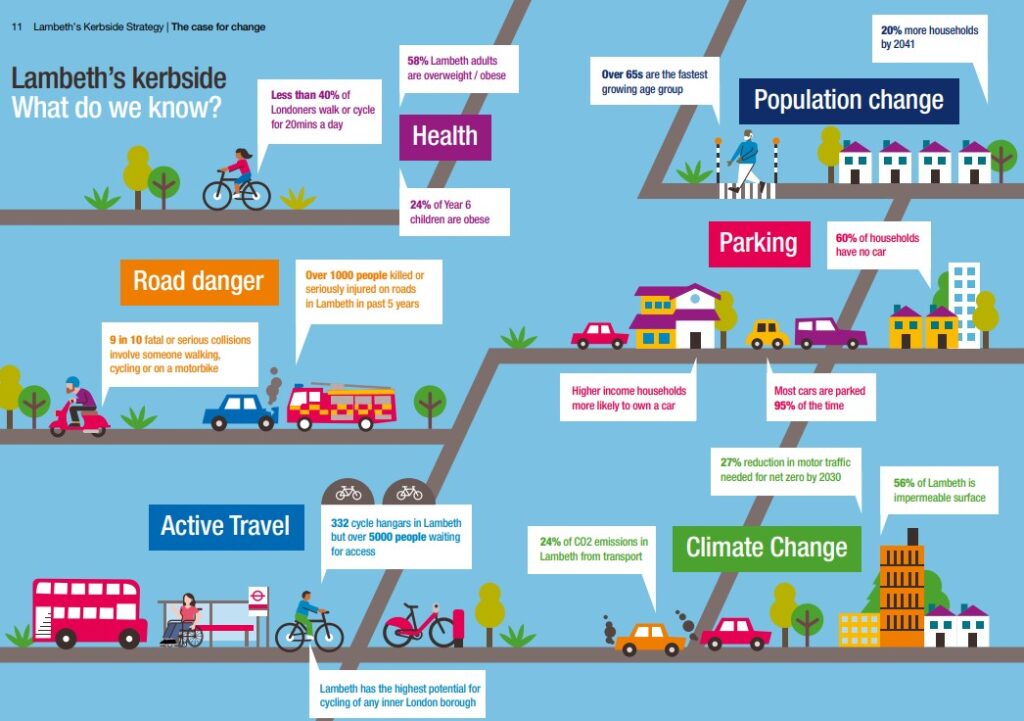ICYMI: Parkicity’s Peter Richards had a ‘Curbside Conversation’ with Journey’s Lauren Mattern. You can read the entire conversation, ranging from best practices to favourite curbside studies, on Journey’s website. This post highlights the section of that article that discusses or favourite strategies that we didn’t write, as well as our favourite curb treatments. Below you can read our segment on What We Like and Dislike at the Curb.
What’s your favorite curb strategy that you didn’t write?
Lauren: The Lambeth Kerbside Strategy covering that borough in London is great – it tracks how the space is used, how that matches (or doesn’t match) their goals, and then sets targets for making progress each year to close that gap. It’s very directive – very clear – and rather than spending a great deal of time saying every street or district is unique, it acknowledges that every street needs to function better. Stormwater management is a big theme so it calls for stormwater urban drainage systems on every block recognizing that universal need. I believe it also takes a clear-eyed view of sidewalk accessibility and the need to move things off of the “pavement” (British for sidewalk) and into the curb lane to allow for wheel accessibility and for more walking space.

Pete: That’s a tough one. I would lean towards San Francisco – embarrassingly, I had it printed and sitting on my bedside table for months – it’s so pretty and well laid out! It is interesting since it followed the SFpark program in its development, it is a smaller city footprint but pretty dense. San Francisco is also an early adopter of many technologies (whether they agree or not) – Uber first launched there, Waymo had SF as one of its first deployments – so there is a lot going on to consider.
What is your favorite curb treatment?
Pete: I generally like clever, adaptive treatments that create (dual purpose) curb space vs. fixed and rigid designations. One example is from the Curbside Management Strategy in Toronto, and how they turned fire hydrants into taxi stands (and shameless plug – you can read all about it in the Parkicity blog post on it here).

Lauren: I like strategies that clear sidewalks for improved accessibility – so a plan to move bins, trees, or street furniture further out into curb lane to (effectively) widen sidewalks. One far-flung example of that would be consolidated garage and recycling bins, European style (now coming to New York). I’m always impressed with well-designed stormwater or shade curb uses that improve the experience of being on the street while doing double duty of adding shade and improving water management – sometimes trip duty when they bump out for a shorter pedestrian crossing or serve as a buffer for cyclists or pedestrians.

Pete: This seems like a good question to have people submit comments or post on our feed to crowdsource an answer! For any readers, please do comment on this post or LinkedIn and share your favorite creative use or treatment you’ve seen.
What’s your curb pet peeve?
Lauren: Time limits! The way people travel is only getting more flexible. The idea of super rigid travel patterns seems very outdated. I’m pretty surprised at how many shorter time limits are still out there – when we have pricing to control demand and keep a space open, rather than outdated time limits. I don’t like the idea of chasing a customer away early from a shopping or dining trip.
Pete: That’s an interesting point that I hadn’t considered! On my end, I think it is carving up the curbside into too many specific or assigned uses, and to your point, not being flexible. While I think it may be challenging and costly to implement, I feel the future of the curb will be dynamic and flexible. I know the theory is there, but I’m unsure if the reality will truly catch up. But outside of key assigned parts of the curb, such as for accessible needs or perhaps loading, segregating your curbside for ‘this use’ which may sit empty all day and then punishing the busy users who want to use that empty curb space seems counter to what cities should want to do at the curbside.
Curbs are an evolving topic – let us know what you found most helpful or want us to chime in on next. Reach out if you want to talk about curb strategies.
Peter Richards can be reached at pete@parkicity.com and at Parkicity’s website.
Lauren Mattern can be reached at lauren@journeymobility.co and at Journey’s website.